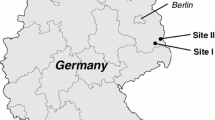Summary
Horizontal wind speed patterns above a scarce millet row crop on inhomogeneous sandy soil revealed insufficient protection from hot winds by multiple shelterbelts in semi-arid Northern Nigeria. This appeared mainly due to too high distances between the belts. Marked yield drops occurred with distance between the belts, in what McNaughton defined (under mechanical damage and microclimate disturbance from strong winds) as the unprotected wake zone. These may, in the case of hot winds, mainly be attributed to combined negative effects on soil moisture and crop physiology of the combination of turbulence, worsened by the shelterbelts, and advected heat. Other parameters confirm the picture of the wake zone and the quiet zone, the latter also being present windward of the belts in a reduced form. The results have serious consequences for the design rules of multiple shelterbelts and alternatives under African semi-arid conditions.
Similar content being viewed by others
Author information
Authors and Affiliations
Rights and permissions
About this article
Cite this article
Onyewotu, L., Stigter, C., Oladipo, E. et al. Air movement and its consequences around a multiple shelterbelt system under advective conditions in semi-arid Northern Nigeria. Theor Appl Climatol 79, 255–262 (2004). https://doi.org/10.1007/s00704-004-0068-1
Received:
Revised:
Accepted:
Published:
Issue Date:
DOI: https://doi.org/10.1007/s00704-004-0068-1




